Question Answer For All Chapters – English Poorvi Class 8th
Let us do these activities before we read. (Page 101)
I Work in pairs. Solve the crossword puzzle given below with the clues in the form of anagrams.
Across: 3. Declare 6. Tucks 7. Heart 9. Felt 10. Sown 12. Sword 13. Evil
Down: 1. Aces 2. Read 4. Tool 5. Alps 6. Hooks 8. Mane 11. Loves
Answer:
II Work in pairs. Match the different meanings of ‘case’ in Column 2 with the correct usage in the sentences in Column 1. Share your answers with your classmates and teacher.
Answer:
| Column 1 | Column 2 |
|---|---|
| 1. Lalit said that he could not sing but that was not the case as he sang melodiously later. | (iii) situation |
| 2. The lawyer was waiting for the case to be taken up in court. | (iv) matter |
| 3. My pencil case is a gift from my grandmother. | (ii) container |
| 4. The subject of a formal letter is written in title case. | (i) writing format |
Let us discuss (Page 104)
I Complete the following statements with suitable reasons. Share your answers with your classmates and teacher.
1. Leroy’s nickname was Encyclopedia and everyone called him by that name because ______________.
2. At the dinner table on Tuesday night, Chief Brown stared at his cream-of-mushroom soup as ______________.
3. Encyclopedia sat quietly at the dinner table because ______________.
4. Nolan put the will on the kitchen table because ______________.
Answer: Leroy’s nickname was Encyclopedia and everyone called him by that name because his head was filled with facts like an encyclopedia, and he never forgot anything he read.
At the dinner table on Tuesday night, Chief Brown stared at his cream-of-mushroom soup as he had a mystery he could not solve.
Encyclopedia sat quietly at the dinner table because he knew his mother and father were discussing the case for his benefit.
Nolan put the will on the kitchen table because he realised he was dying and wanted Davenport to inherit everything he owned.
II Do you think Chief Brown would need Leroy’s help to solve this case? If yes, why? If no, why not?
Answer: Yes, Chief Brown would need Leroy’s help because Encyclopedia was able to decode the four mysterious words into a clue, something even Chief Brown could not figure out.
Let us discuss (Page 107-108)
I A fact is something that can be proven true or false. A fact is not based on people’s beliefs. An opinion on the other hand is a belief, feeling, or judgement, and can vary from one person to another. An opinion cannot be proven. Identify which of the following statements from part I and II of the story are facts or opinions. One example has been done for you. Share your answers with your classmates and teacher.
1. Encyclopedia’s father was the Chief of Police. Fact
2. Everyone thought that Chief Brown must be the smartest police chief in the country.
3. An encyclopedia is a book or set of books filled with facts from A to Z.
4. Leroy’s friends said that he was like a library and computer rolled into one, and more user-friendly.
5. Two masked men held up the Diamond Mart on Sixth Avenue.
6. Nolan and Davenport had met while both were in prison in South Carolina.
7. Chief Brown’s hunch was that Davenport and Nolan decided to hide the loot until things cooled down.
8. Nolan wrote a four words code to tell Davenport where he had hidden the stolen jewellery.
Answer:
- Fact
- Opinion
- Fact
- Opinion
- Fact
- Fact
- Opinion
- Fact
II Complete the table by choosing the character traits of Leroy given in the box below. There is an extra word that you do not need. One example has been done for you.
Answer:
| Textual Evidences | Traits |
|---|---|
| 1. He read more books than anyone in Idaville, and he never forgot a fact. | Knowledgeable |
| 2. Encyclopedia never spoke of the help he gave his father. He didn’t want to seem different from other boys. | Humble |
| 3. Encyclopedia sat quietly. He knew his mother and father were discussing the case for his benefit. | Keen listener |
| 4. Usually, he needed to ask only one question to solve a case before dessert. | Cleverness |
Let us think and reflect (Page 108-110)
I Read the given extracts and answer the questions that follow.
1. Chief Brown would have liked to tell everyone about his only child. But who would believe him? Who would believe that the best detective alive was an eighth grader? So, he said nothing.
Encyclopedia never spoke of the help he gave his father. He didn’t want to seem different from other boys. But there was nothing he could do about his nickname. He was stuck with it.
Only his parents and teachers called him by his real name, Leroy. Everyone else called him Encyclopedia.
(i) Complete the following sentence with a suitable reason.
Chief Brown’s dilemma can be called unique because____________.
Answer: (i) Chief Brown’s dilemma can be called unique because nobody would believe that the best detective alive was just an eighth grader, his own son.
(ii) What can be inferred about why Encyclopedia never spoke of the help he gave his father?
A. He is shy and lacks confidence in his abilities to share his insights.
B. He wants to avoid the jealousy others might feel about his skills.
C. He desires to blend with the other boys to prevent seeming different.
D. He is embarrassed about being smarter than most adults around him.
Answer: C. He desires to blend with the other boys to prevent seeming different.
(iii) The parents choose not to call their son ‘Encyclopedia’. Select the reason that is false.
A. For them he is more than his unique abilities; he is their child, with a personal identity.
B. Calling him by his real name reflects their affection and the desire to acknowledge him as an ordinary boy.
C. They want him to be remembered as different from the others around.
Answer: C. They want him to be remembered as different from the others around.
(iv) What does the writer mean by the fact that Leroy was ‘stuck with’ the name Encyclopedia?
Answer: (iv) The writer means by saying Leroy was ‘stuck with’ the name Encyclopedia that he could not escape the nickname since everyone used it, whether he liked it or not.
2. Chief Brown studied the four words: Nom Utes Sweden Hurts. He shook his head and passed the notebook to Mrs. Brown again. “Can you figure it out?”
“Nom is a shortening of nominative, a grammatical term,” stated Mrs. Brown, who had taught English and other subjects in high school.
“Utes is an American Indian tribe. Sweden is a country in northern Europe. Hurts is hurts.”
She lifted her gaze to Encyclopedia and shook her head.
“I can’t figure it out,” she confessed.
“Davenport disappeared right after the hold-up,” Encyclopedia reminded her.
(i) What does Chief Brown’s reaction of shaking his head suggest about his understanding of the four words?
A. He is confident that the words are a clue.
B. He is confused, unable to make sense of the words.
C. He believes the words are random and meaningless.
D. He thinks the words are unrelated to the case.
Answer: B. He is confused, unable to make sense of the words.
(ii) Identify whether the given statement is true or false.
Mrs. Brown explained the actual meanings of the individual words rather than decoding the hidden message behind them.
Answer: True. Mrs. Brown explained the literal meanings of the words, not the hidden code.
(iii) What does Mrs. Brown’s inability to decode the words suggest about the message?
Answer: It suggests that the message was cleverly coded, making it difficult for someone not searching for a clue to understand it.
(iv) Complete the following sentence suitably.
The purpose of Encyclopedia’s reminder in the last line of the extract was to _________________. (refocus the discussion on the context of the crime/suggest that the coded message was meant for Davenport/imply that the message was likely a clue about the location of the stolen jewellery)
Answer: The purpose of Encyclopedia’s reminder in the last line of the extract was to refocus the discussion on the context of the crime and show that the coded message was likely a clue for Davenport.
II Answer the following questions.
1. Nolan and Davenport were very close. Support this statement with evidence from the text.
Answer: Nolan and Davenport had met in prison, became friendly, and Davenport came to live with Nolan a week before the jewellery hold-up. Nolan also left everything he owned, including his palm-tree nursery, to Davenport in his will. This shows their closeness.
2. Why did Davenport disappear right after the jewellery hold-up? What might his plans have been if, Nolan had not died?
Answer: Davenport disappeared after the hold-up to avoid being caught, as he and Nolan had likely hidden the stolen jewellery. If Nolan had not died, Davenport probably planned to return later and collect the jewellery once things had cooled down.
3. What does Mrs. Brown’s interest in the case tell us about her?
Answer: Mrs. Brown is intelligent, curious, and observant. She actively discusses the case, tries to decode the message, and supports her husband and son in solving mysteries, showing her sharp mind and involvement.
4. Explain why Chief Brown was proud of his son.
Answer: Chief Brown was proud because his son, though only in eighth grade, was smarter than many adults and could solve complex mysteries that even experienced police officers couldn’t solve.
5. Why were Chief Brown’s suspicions regarding Nolan and Davenport justified, even when there was a lack of concrete proof?
Answer: A clerk thought she recognised Nolan during the robbery, Davenport disappeared immediately after the crime, and neither was proven innocent. These suspicious actions justified Chief Brown’s doubts about their involvement.
6. Analyse the role of the four-word coded message in the story.
Answer: The coded message—“Nom Utes Sweden Hurts”—was the key to solving the mystery. It cleverly represented the days of the week, pointing to “Friday” (the missing fifth word) and the location of the jewellery under the fir tree. Without this code, the stolen jewellery would not have been found, showing its central role in the story.
7. Write a character sketch on Leroy with the help of the character traits table given in ‘Let us discuss’ section.
You may begin it like this:
Encyclopedia was a knowledgeable eighth grader who never forgot a fact that he read.
Answer: Encyclopedia was a knowledgeable eighth grader who never forgot a fact that he read. He was clever, humble, and an excellent listener. Despite his extraordinary detective skills, he never bragged about his achievements and preferred to stay like other boys. His calm and logical thinking helped him solve mysteries that even adults struggled with. He had a sharp eye for detail, great reasoning skills, and used intelligence and patience to crack cases.
Let us learn (Page 111-117)
I Match the phrasal verbs from the text given in Column 1 with their meanings in Column 2. You may refer to a dictionary.
Now, fill in the blanks with the phrasal verbs given in Column 1.
A. Finally, some important evidence about the case has _______________.
B. After I _______________, I understood that I had made a big mistake.
C. I couldn’t _______________ why he was angry with me.
D. He _______________ his special coat and went to his friend’s birthday party.
E. Ravi forgets to do his homework but he _______________ it as teacher didn’t ask for it that day.
F. I do not know what to _______________ his behaviour.
Answer: A. turned up
B. cooled down
C. figure out
D. put on
E. got away with
F. make of
II Fill in the blanks in the following sentences by choosing the correct word pairs from the box given below.
1. After running for 50 kilometres last _________________, I felt _________________ for two days.
2. When the committee met yesterday, they brought _________________ local cases to the _________________.
3. While learning to drive, Rina used too much force on the
_________________, causing the car to _________________ down.
4. He has composed a beautiful _________________ of music in order to bring _________________ to thousands of people.
5. She was busy _________________ her hair not caring about the _________________ flowers in her garden.
Answer: 1. week, weak
2. four, fore
3. brake, break
4. piece, peace
5. dyeing, dying
III Leroy solved the mystery of the missing fifth word with his critical thinking abilities. Work in pairs to solve the puzzles given in the illustrations below and infer what they say. One example has been done for you.
Answer:
- Middle Aged
- Try to understand (Try + stand / 2 = “understand”)
- Up to you (arrow pointing up + “uu”)
- Go for it (GO + four “It” = “Go for it”)
- Common sense (the word sense written many times with one circled → “common sense”)
- One in a million (M1LLION → 1 in a million)
- Once upon a time
- Crossroads
IV Spoonerism is a mistake made when speaking, where the first sounds of the words in a phrase or a sentence are exchanged with each other.
This usually gives a funny meaning.
Some examples of spoonerism are saying ‘wrong load’ instead of ‘long road’, ‘round of mice’ instead of ‘mound of rice’.
Find the correct order for the following spoonerisms.
1. knowing sits 2. it’s roaring with pain.
3. plaster man 4. blarm wanket
5. tars and crucks 6. shake a tower
7. bead a rook 8. mardon me padam
Answer:
- knowing sits → Snowing kits
- it’s roaring with pain → it’s pouring with rain
- plaster man → master plan
- blarm wanket → warm blanket
- tars and crucks → cars and trucks
- shake a tower → take a shower
- bead a rook → read a book
- mardon me padam → pardon me, madam
V Read the following sentences from the text and study the highlighted words.
1. Everyone thought that he must be the smartest police chief in the country.
2. She read what he had copied.
3. They tell where the jewellery is hidden.
4. “Nom is a shortening of nominative, a grammatical term,” stated Mrs. Brown, who had taught English and other subjects in high school.
5. “Nolan and Davenport had met,” Chief Brown said, “while both were in prison in South Carolina.”
6. When he came up against a case he couldn’t solve, he acted at once.
7. The code is simple, especially as it’s written on a sheet from a calendar.
8. They became friendly because of shared interests.
9. Encyclopedia solved the case for him before dinner was over.
Now, fill in the blanks with the words in the box given below to complete the following sentences. There are two extra words that you do not need.
Detective stories are exciting, keeping readers guessing (i) ____________ the real culprit is. They take place in settings (ii) ____________ clues are hidden carefully. (iii) ____________ the mystery seems tricky, a clever detective always finds answers. Readers often wonder (iv) ____________ criminals leave small but important clues. The challenge is to decide (v) ____________ suspect is guilty. (vi) ____________ the truth is revealed, everything makes sense. But one may wonder (vii) ____________ they could have solved it themselves. These stories are fun (viii) ____________ they make readers think till the very end.
Answer: (i) who
(ii) where
(iii) Though
(iv) why
(v) which
(vi) When
(vii) if
(viii) because
VI Combine the following pairs of sentences using the word given in brackets. One example has been done for you.
1. We gave him the signal. He was waiting for the signal. (that)
Answer: We gave him the signal that he was waiting for.
2. We went to a place. The incident occurred there. (where)
Answer: We went to the place where the incident occurred.
3. Teacher said she would retire soon. She is now nearly sixty. (who)
Answer: Teacher, who is now nearly sixty, said she would retire soon.
4. It was the day. Half the class was absent. (when)
Answer: It was the day when half the class was absent.
VII Read the following sentences from the text.
1. “What’s suspicious about that?” Mrs. Brown asked.
2. “What do you make of the four words, Leroy?”
3. “Wasn’t he mixed up in a jewellery robbery a few years ago?”
4. “Didn’t you search Nolan’s house, dear?”
5. “Is there a young fir tree in Mr. Nolan’s palm-tree nursery?”
The given sentences are the direct words of the speaker, hence, they are in direct speech.
While reporting these direct words to someone else at some other time and some other place, we make certain modifications in person, tense, and adverbs of place and time.
Answer: 1. Mrs. Brown asked what was suspicious about that.
2. Mrs. Brown questioned Leroy what he made of the four words.
3. Mrs. Brown inquired if he had been mixed up in a jewellery robbery a few years before.
4. Mrs. Brown asked Chief Brown if he had searched Nolan’s house.
5. Mrs. Brown inquired if there was a young fir tree in Mr. Nolan’s palm-tree nursery.
VIII Rewrite the following sentences in Reported Speech.
1. “Why did you stop talking to me?” asked Rohan.
Rohan questioned __________________________________________________.
2. “Did you enjoy the family gathering yesterday?” asked my aunt.
My aunt asked ______________________________________________________.
3. “When will you visit us again?” asked my grandmother.
My grandmother inquired _________________________________________.
4. Madavi said to Ravi, “Will you come with me to meet our old teacher tomorrow?” asked Madavi.
Madavi asked Ravi __________________________________________________.
5. My friend said, “What gift are you planning to give your brother?”
My friend inquired _________________________________________________.
6. “Shall I carry these notebooks to the staffroom, Ma’am?” asked Veenu.
Veenu asked her teacher ____________________________________________.
Answer: Rohan questioned why I had stopped talking to him.
My aunt asked if I had enjoyed the family gathering the day before.
My grandmother inquired when I would visit them again.
Madavi asked Ravi if he would go with her to meet their old teacher the following day.
My friend inquired what gift I was planning to give my brother.
Veenu asked her teacher if she should carry those notebooks to the staffroom.
IX Read the conversation between Aditi and Rahul.
ADITI: Did you see anyone leave a package near the lift?
RAHUL: I noticed a man wearing a blue jacket drop it off.
ADITI: What time did you see this happen?
RAHUL: It was around 6:45 p.m.
ADITI: Were you able to see his face?
RAHUL: He wore a hood and so I couldn’t see his face.
Complete the following paragraph by transforming the dialogue in indirect speech.
Aditi asked Rahul 1. ___________________________________________________.
Rahul replied that he had noticed a man wearing a blue jacket drop it off.
Aditi asked Rahul 2. ___________________________________________________.
Rahul replied that it had been around 6.45 p.m.
Aditi further inquired 3. _______________________________________________.
Rahul said that he had worn a hood, so he couldn’t see his face.
Answer: Aditi asked Rahul if he had seen anyone leave a package near the lift. Rahul replied that he had noticed a man wearing a blue jacket drop it off. Aditi asked Rahul what time he had seen that happen. Rahul replied that it had been around 6.45 p.m. Aditi further inquired whether he had been able to see the man’s face. Rahul said that he had worn a hood, so he couldn’t see his face.
Let us listen (Page 117)
I You will listen to a podcast about ways of improving observation skills.
As you listen, mark the statements 1–4 as true or false. (Transcript for teacher on page 151)
1. Observation skills help improve your common sense.
Answer: True
2. Rushing through tasks helps you focus better and observe more.
Answer: False
3. Taking notes or making sketches helps with what you observe.
Answer: True
4. Incorporating tips on observation skills will soon lead to success.
Answer: True
II You will once again listen to the podcast. As you listen, complete the given sentences by filling in the blanks with one to three exact words you hear.
1. It is important to slow down and ___________________ to notice several aspects around you more clearly.
2. The more senses like hearing and smelling you use, the more ___________________ you absorb.
3. People who are ___________________ tend to be better observers because they seek to understand what they notice.
4. When you make a note of things, it helps reinforce the ________________ in your memory.
5. Practising mindfulness helps a person stay ___________________ with their surroundings.
Answer: 1. take your time
2. information
3. curious
4. details
5. engaged
Let us speak (Page 118)
I Read the following words from the text loudly with the help of pronunciation guide given in brackets.
Now, practise reading the following words.
Answer: Do it yourself.
II Work in groups of five or six. Conduct a group discussion on the topic,
‘The Interesting Aspects of a Mystery Story’.
Guidelines
The moderator initiates the discussion inviting the speakers to share their view son the subject.
The speakers take turns to put forth their viewpoint using polite expressions to agree or disagree.
The speakers may interrupt by raising their hands to add or clarify a point.
The moderator ensures equal participation of all the members in the group, consolidates views, and calls upon other speakers to respond.
The moderator sums up the points of discussion, suggests guidelines for future action and thanks the members of the group.
Note: Choose a moderator. Decide upon the duration of the discussion.
Answer: Do it yourself.
Let us write (Page 119-121)
I A report is written for an event that has already occurred. The purpose of a report is to provide first-hand details of an incident or event. It presents the information in a proper sequence.
Read the sample report written about the ‘Inter-school Football Tournament’ organised by your Vidyalaya.
Note the format, content, and language used.
Now, asamember of the Art and Craft Club,writeareport on an ‘Inter-school Art Exhibition’ organised by your school. Include the necessary details.
Answer:
Inter-school Art Exhibition by [Your Name], Class VIII
An Inter-school Art Exhibition was organised by our Vidyalaya from 15 September 20XX to 17 September 20XX in the school auditorium. Ten schools from the city participated in the exhibition.
The event was inaugurated by the Chief Guest, Mrs. Sharma, a well-known artist, on Friday, 15 September 20XX. The exhibition was open for visitors from 10:00 a.m. to 3:00 p.m. on all three days. Students from various schools showcased paintings, sketches, sculptures, and craftwork. The creativity and hard work of the participants were widely appreciated by all.
On the final day, the winners were announced in different categories. The exhibits were judged based on originality, use of colours, and presentation. The first prize was awarded to Greenfield Public School, and the second prize went to Sunshine High School.
The Chief Guest distributed certificates and trophies to the winners and encouraged all participants to continue exploring their creativity. She remarked, “Art reflects the imagination and talent of young minds.” The exhibition was a grand success, inspiring students and visitors to appreciate and promote artistic expression.
Let us explore (Page 121)
I Work in pairs. Read the words and observe the images given below. Check if your answers match. Share your answers with your classmates and teacher.
These are optical illusions which may trick the eye and make you think that you can see two different things.
Answer: The word “Learn” can also be seen as “Teach.”
The word “Hate” can also be seen as “Note.”
The word “God” can also be seen as “Evil.”
The tree with branches also looks like ape on one side and a tiger on the other.
The penguin can also be seen as the side profile of a person’s face.
The columns also create the silhouette of people standing.
II Read the steps to play a language game—Name the Mystery Object.
1. Divide the class into teams.
2. Each team chooses an object and prepares three hints to enable the other teams to name the object.
3. Each team takes turns to name the object given by the other team.
4. If a team names the object with the first hint, they get 20 points, with the second hint 10 points, and with the third hint 5 points.
One example with three hints:
(i) I display information for all to share, with a swipe I’m clean and bare.
(ii) I am rectangular or a square, whom neither teacher nor student can spare.
(iii) I am mostly black, sometimes green, now in white too I am seen.
Answer: The answer is a blackboard or a whiteboard, or a greenboard.
III Visit the library and look for an encyclopedia. What is it? Check how it is different from a dictionary. Share your answers with your classmates and teacher.
Answer: An encyclopedia is a book that gives detailed information about many subjects like history and science. A dictionary is different because it lists words in order and explains their meanings and pronunciation. The main difference is that an encyclopedia explains topics, while a dictionary explains words. Encyclopedias often have pictures, but dictionaries mostly have short definitions.
IV A thesaurus is a reference book or digital tool that provides a collection of words with similar meanings, allowing users to find alternative words or phrases to express the same idea. Choose any five words and find out their alternative words from the thesaurus.
Answer:
| Word | Alternative Words (Synonyms) |
|---|---|
| 1. Happy | glad, cheerful, joyful, delighted, content |
| 2. Big | large, huge, enormous, gigantic, massive |
| 3. Fast | quick, speedy, rapid, swift, brisk |
| 4. Beautiful | lovely, attractive, gorgeous, stunning, charming |
| 5. Smart | clever, intelligent, bright, sharp, brilliant |

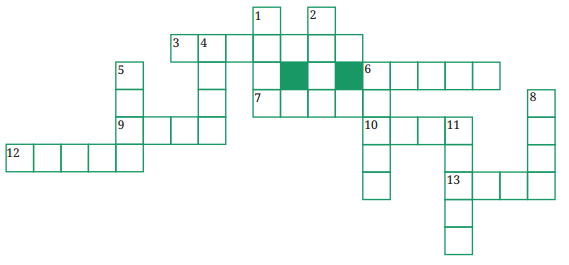
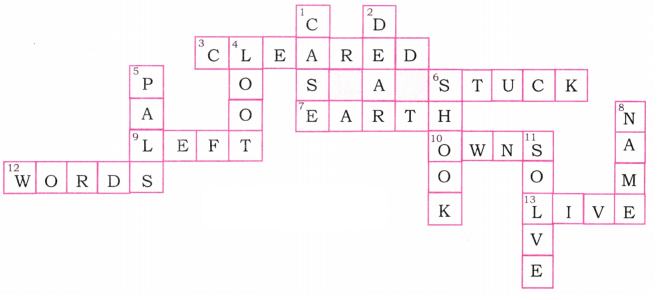


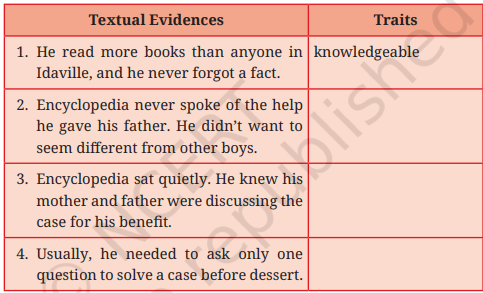
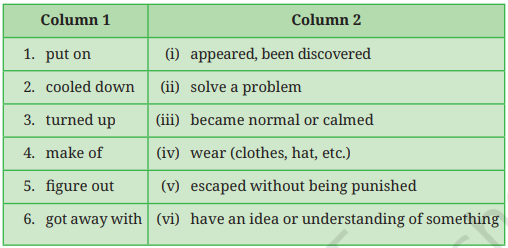

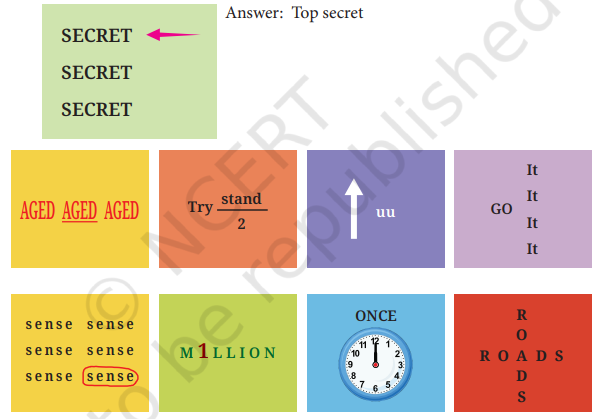

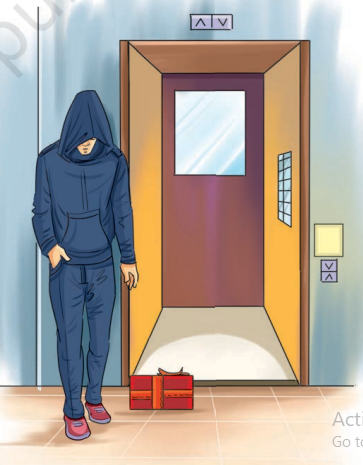
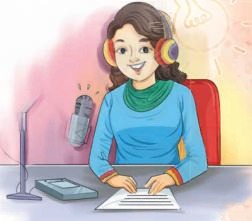

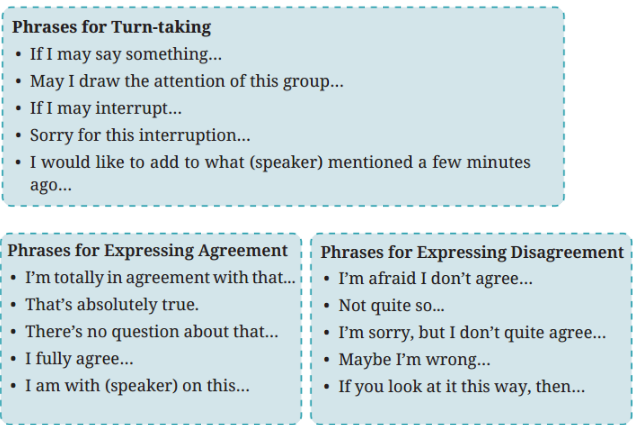
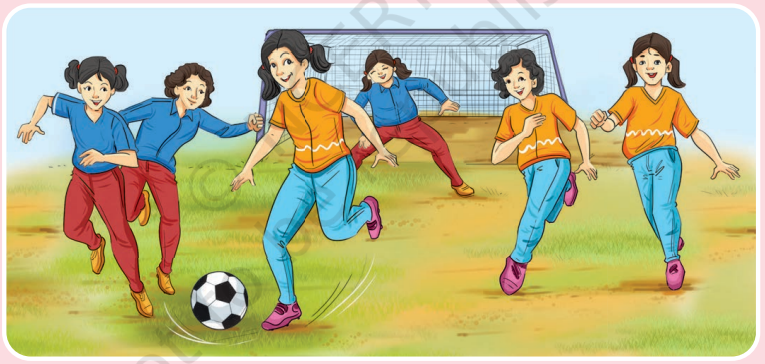
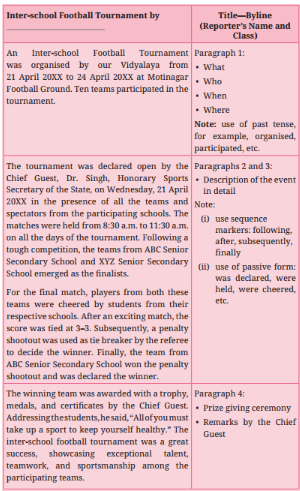


Leave a Reply